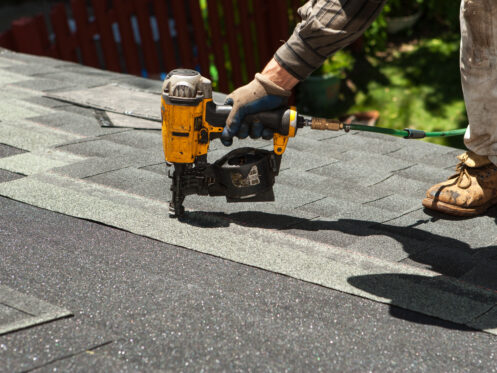After a strong windstorm, your roof may be more vulnerable than you realize. High winds might damage flashing, loosen shingles, and even cause leaks, exposing your house to the elements. But if your roof has been compromised, how would you find out? Although identifying wind damage is not always easy, knowing the main signs will enable you to act before minor problems become expensive repairs. Learn more about the signs of wind damage and what to do if you find any, ensuring your roof remains pristine.
Inspect Your Roof for Missing or Loose Shingles
Wind can damage shingles, especially if they are old or have been worn down over time. Loss or damage to shingles is one of the first signs of wind damage. Storms with strong wind can lift your roof’s shingles off, revealing the underlayment. This makes the roof less effective at protecting your home from the weather and makes it more likely that water will get in.
When inspecting your roof, take a close look at the shingle pattern. Are there gaps or irregularities? Missing shingles are often easy to spot, but loose shingles can be trickier. The wind may have blown the shingles loose, causing the edges to peel off the roof. Look for shingles that appear lifted, curled, or out of alignment.
Check for Damaged Flashing Around Chimneys and Vents
Flashing is an essential part of your roof that protects and seals the areas around chimneys, vents, skylights, and other roof penetrations. However, flashing can get damaged or loose during a storm, leaving your roof open to rainfall seeping in. Damaged flashing can be a big problem since it’s not always noticed until there’s a leak. Look at the flashing around the roof’s openings to see if there is damage. Check for signs of cracks, bending, or missing pieces.
Keep an extra close watch over the spots where the flashing touches the roof. If there are cracks, gaps, or separations between the flashing and the roof, water can get in and cause leaks and damage to the structure. Also, you need to check the sealant around the flashing. The sealant can crack or peel off in the wind, making the flashing even less effective.
Look for Dents or Cracks in Roof Shingles
Dents and cracks in roof shingles are clear signs of wind damage, especially if hail or other flying objects were present in the storm. These damages may compromise the shingles’ structural integrity, increasing their vulnerability to leaks and additional deterioration. When strong winds blow things onto the roof, they often hit and dent it. Small dents might not seem like an issue initially, but they can cause bigger problems over time, like water pooling in the holes and eventually seeping through to the roof deck.
On the other hand, cracks are more urgent because they jeopardize the shingles’ ability to keep water out. Before beginning your roof inspection for dents or cracks, start by carefully examining the shingles for any irregularities. Regarding appearance, teeth can be small, shallow depressions, and cracks can be anything from tiny fractures to larger splits. Because damage can occasionally be localized, examine the entire surface of each shingle.
Examine Gutters and Downspouts for Signs of Wind Impact
Not only can wind damage your roof, but it can also hurt your gutters and downspouts. Although these critical parts of your home’s drainage system are meant to keep water away from your roof and foundation, strong winds can knock them out of place or fill them with dirt and other debris.
First, look for parts that look bent, twisted, or coming away from the roofline. Gutters are easy to move with the wind, especially if they are loose or not secure. If your gutters aren’t lined up right or are missing, water can pool on your roof or near the foundation of your home.
Next, look inside the gutters for things the wind may have blown in. Gutters can get clogged with leaves, twigs, and other debris, making it hard for water to flow. This could lead to water backing up and spilling over, hurting your roof and siding. Lastly, make sure the downspouts are attached securely.
Identify Water Stains or Leaks Inside Your Home
There may be damage to the outside of your roof, but water getting into your living spaces is, sometimes, the first sign of a problem. First, look at your ceilings. There may be a leak if you see discoloration, water stains, or paint peeling off.
Also, pay attention to musty smells. Musty smells could mean that there is hidden water damage or mold growth. Next, look at the walls near the roof openings, skylights, and other windows. Wind-driven rain can get through small holes in the roof or around flashing and cause leaks that might not be obvious initially. Along the walls and around the window frames, look for wet spots or other signs of water damage. It’s also important to check your attic if you have one. Check the insulation and floor for any signs of water damage.
Spot Shingle Granules in Your Gutters or Yard
If you find shingle granules in your yard or gutters, your roof may have been damaged by wind. Shingle granules are small, coarse particles that coat the surface of asphalt shingles, providing protection against UV rays and adding an extra layer of durability. However, strong winds can cause these granules to loosen and wash away, leaving your shingles more vulnerable to the elements.
Take the time to look in your gutters and downspouts for granules gathered after a storm. If you see a lot of granules, your shingles may be wearing down faster than you thought. Loss of granules can leave bald spots on the shingles, which makes them more likely to crack, curl, and let water in.
Assess the Condition of Roof Edges and Eaves
Start by looking closely at the shingles that are close to the roofline. Search for any that look off, lifted, or loose. Shingles can curl or bend at the edges when it’s windy, leaving holes for water to enter. Pay close attention to the drip edge, which is the metal flashing installed around the roof’s edges.
Water should go away from the roof and into the gutters through the drip edge, but wind can sometimes lift or damage this flashing, making it less effective. Look for signs that the drip edge is bent, coming apart, or missing. Lastly, look under the eaves for signs of water damage, like paint peeling off, rotting wood, or water stains.
We Can Repair Roof Damage Caused by the Elements
Often resulting in more problems if not quickly addressed, wind damage can seriously compromise the integrity of your roof. Your Dallas home can be kept from more damage by knowing what indicators to spot and acting fast. Ensuring your roof stays strong and resilient against the next storms depends mostly on routine roofing inspections and maintenance performed by our roofers. We also provide roofing repair, roofing maintenance, roofing installation, solar panels, solar storage, and Tesla solar services.
Contact KPost Company in Dallas today for professional advice and reliable roofing services you can trust.

